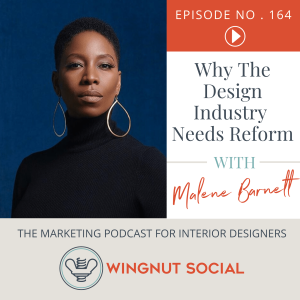
There is a severe and noted underrepresentation of Black artists and designers in the design industry. Issues of cultural misappropriation are coupled with a lack of historical and cultural awareness—and it needs to change. Malene Barnett sought to bring about change when she founded the Black Artists + Designers Guild (BADG) in 2018, with a mission to “Build a more equitable and inclusive creative culture by advancing a community of independent Black artists, makers, and designers in creative industries.”
Malene Barnett is an artist based in Brooklyn, NY. She founded the Black Artist + Designer’s Guild to combat a lack of representation of Black talent and culture in the design industry. It is a global platform seeking to represent a curated collection of independent Black artists, makers, and designers at the top of their game.
What You’ll Hear On This Episode of Wingnut Social- [1:25] Natalie’s TikTok themed dreams
- [3:30] Malene Barnett’s background in art + design
- [5:50] Bringing issues of inequality to the forefront
- [9:05] Had Malene seen improvement with the movement?
- [10:55] The biggest challenge was getting support and people behind it
- [12:27] What is the selection process like for designers who want to join?
- [15:14] What does demolishing and rebuilding look like in education?
- [16:34] Credit must be given to the originators
- [18:20] Steps to take to support change (+ design reform)
- [21:40] Cultural misappropriation in the design world
- [24:06] What the mission and vision of the Black Artists + Design Guild
- [26:53] What up Wingnut! Round
- [29:02] How to connect with Malene Barnett
- [32:26] Blooper Reel!
- Black Artists + Designers Guild
- BADG on Instagram
- Malene’s Design Website
- Malene on Instagram
- Connect on LinkedIn
- Follow on Twitter
- BOOK: I’m Not Done Yet by Dr. Cynthia Barnett
- BOOK: White Fragility by Robin DiAngelo
- BOOK: Me and White Supremacy by Layla Saad
- What’s New What’s Next
- Fabricut
- Made Goods
- Vaughan Lighting
- De Le Cuona
- Elle Decor
- House Beautiful
- Luxe Magazine
- Business of Home
- Architectural Digest
When Malene founded BADG the support she garnished was very minimal. People would say, “Oh, that’s a nice gesture” but weren’t truly supporting her vision. ButMalene didn’t ask anybody for anything. She points out that most Black-owned businesses don’t have access to loans or family members who can invest in them. They’ve always relied on their community to support them. That’s why there needs to be more support from the design industry.
With the recent movement brought to the forefront, Malene is seeing large companies reach out to develop long-term partnerships. It’s a step in the right direction. But there still needs to be significant improvement. Malene emphasizes that systems need to be demolished. This awareness of social justice and equality isn’t new. The uproars have happened over time. Malene notes that it’s a constant battle: “We’ve always been fighting for the right to just be and be human.”
There’s a lot of work that has to be done. Malene shares how the design industry is one of the least transparent industries—keep listening to hear why.
Design education needs to be demolished and rebuiltMalene firmly believes that the whole design education system needs to be rebuilt. She points out that if you go to school for design, you’re usually being taught from the European perspective. Students are being fed the lie that modern design is European—but it isn’t. Modern design is of African descent.
Malene uses Picasso as an example. He is credited with being one of the most influential artists of the 20th century—but much of his work isn’t truly his. He spent time in West Africa studying Yoruba sculptures. He was given the credit for the movement, but the basis of his art was Yoruba art.
“We need to rewrite this narrative and give the credit to the originators of creativity and design and start leading with the indigenous voices—with the Black voices—and then talk about how these principles have been influenced in a particular person's practice versus the other way around.”
Designers must educate themselves on Black culture and design. Malene points out that designers are using Kuba cloth from the Congo and Mud Cloth from Mali in their design as decorative items. This is cultural misappropriation. If Malene were to use it in her design, she’d be labeled as being “too ethnic”. “Ethnic” in and of itself is the wrong word to use. Malene points out that it has been used as a label for anything that’s non-white—and she refuses to accept that.
Malene emphasizes that “This industry has been using black culture so much when it comes to design but yet not giving the credit to the people, to the community, to the culture—and all of that has to change.”
Combating racism and underrepresentation begins with personal changeMalene asks, “How uncomfortable do you want to get? How much are you willing to give up?” She notes that supporting the movement is about going deeper and starting with working on yourself. It will require asking difficult questions and a willingness to be uncomfortable.
Decolonize yourself, read books and articles, attend events—learn about your industry. Take a good hard look at difficult topics such as redlining, the division of neighborhoods, and the homeownership disparity. Then you branch out and educate your friends and your family.
What steps can you take to support BADG and Black Lives Matter? How can the design industry push for the necessary change and reform? Where can you learn more? Listen to this episode for more information and an eye-opening design education you've probably never gotten.
Connect With Darla & Wingnut Social- www.WingnutSocial.com
- On Facebook
- On Twitter: @WingnutSocial
- On Instagram: @WingnutSocial
- Darla’s Interior Design Website
- Check out the Wingnut Social Media Lab Facebook Group!
- 1-877-WINGNUT (connect with us for your social media marketing needs)
- Article Modern Furniture
Subscribe to The Wingnut Social Podcast on iTunes, Google Podcasts, or TuneIn
Audio Production and Show notes by
PODCAST FAST TRACK
https://www.podcastfasttrack.com
More Episodes
 2024-10-30
2024-10-30
 2024-10-02
2024-10-02
 2024-09-18
2024-09-18
 2024-09-11
2024-09-11
 2024-09-04
2024-09-04
 2024-08-14
2024-08-14
Create your
podcast in
minutes
- Full-featured podcast site
- Unlimited storage and bandwidth
- Comprehensive podcast stats
- Distribute to Apple Podcasts, Spotify, and more
- Make money with your podcast
It is Free
- Privacy Policy
- Cookie Policy
- Terms of Use
- Consent Preferences
- Copyright © 2015-2024 Podbean.com






